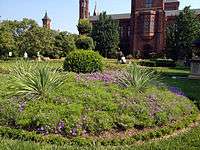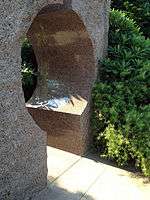Enid A. Haupt Garden
| Enid A. Haupt Garden | |
|---|---|
|
The Smithsonian Castle with the Enid A. Haupt Garden seen in the foreground | |
 | |
| Location | 1037-1057 Independence Avenue Southwest, Washington, D.C. |
| Coordinates | 38°53′17″N 77°01′34″W / 38.88805°N 77.026°WCoordinates: 38°53′17″N 77°01′34″W / 38.88805°N 77.026°W |
| Area | 4.2 acres (1.7 ha) |
| Opened | May 21, 1987 |
| Owned by | Smithsonian Institution |
The Enid A. Haupt Garden is a 4.2 acre public garden in the Smithsonian complex, adjacent to the Smithsonian Castle on the National Mall in Washington, D.C.[1][2][3] It was designed to be a modern representation of American Victorian gardens as they appeared in the mid to late 19th century.[2][4] It replaced an existing Victorian Garden which had been built to celebrate the nation's Bicentennial in 1976.[5]
History
The garden opened on May 21, 1987 as part of the redesigned Castle quadrangle.[6] It is named for Enid A. Haupt, who provided the $3 million endowment which financed its construction and maintenance.[1][2][3] Initially approached with a request that she finance a small Zen garden within the quadrangle, after a review of the plans Haupt said that she was "not interested in putting money into a Zen garden...I'm only interested in financing the whole thing."[7]
The quadrangle redesign project and the Smithsonian Gardens more broadly were part of the vision of the eighth Secretary of the Smithsonian, S. Dillon Ripley, who felt that the museum experience should extend beyond the museums' buildings into the outdoor spaces.[5]
The landscape design of the Garden featured the collaborative efforts of architect Jean Paul Carlhian, principal in the Boston firm of Shepley, Bulfinch, Richardson and Abbott; Lester Collins, a landscape architect from Millbrook, New York; Sasaki Associates Inc. of Watertown, Massachusetts; and James R. Buckler, founding director of the Smithsonian's Office of Horticulture.[6]
The central feature of the garden is a symmetrically patterned parterre, flanked by the Moongate Garden to the west and the Fountain Garden to the east.[2][4] The parterre measures 144 feet long by 66 feet wide; the low-growing plants that fill out the series of diamonds, fleurs-de-lis, and scallops or swags that make up the design are changed every six months, typically in September and May.[3][8]
Other notable design features include saucer and tulip magnolias, brick walkways, and historical cast-iron garden furnishings from the Smithsonian Gardens' Garden Furniture Collection.[2][6]
Gallery
 Moving Magnolia Trees for Haupt Garden
Moving Magnolia Trees for Haupt Garden Ribbon Cutting 1987
Ribbon Cutting 1987 Visitor Playing in Pool of Water
Visitor Playing in Pool of Water NMAfA and Haupt Garden in the Spring
NMAfA and Haupt Garden in the Spring Eighth Secretary of the Smithsonian S. Dillon Ripley with the completed quadrangle and Haupt Garden in the background
Eighth Secretary of the Smithsonian S. Dillon Ripley with the completed quadrangle and Haupt Garden in the background Smithsonian Castle and Haupt garden parterre
Smithsonian Castle and Haupt garden parterre Haupt garden parterre
Haupt garden parterre Haupt garden and carriage gates
Haupt garden and carriage gates Haupt garden planters
Haupt garden planters Haupt garden urn and parterre
Haupt garden urn and parterre Haupt garden Moongate
Haupt garden Moongate Haupt garden Moongate
Haupt garden Moongate Haupt garden Moongate
Haupt garden Moongate Haupt garden Moongate garden and Castle
Haupt garden Moongate garden and Castle Haupt garden Moongate pool and Castle
Haupt garden Moongate pool and Castle Haupt garden Moongate pool
Haupt garden Moongate pool Enid A. Haupt Garden
Enid A. Haupt Garden
References
- 1 2 Smithsonian Gardens. "Enid A. Haupt Garden". Retrieved 24 May 2012.
- 1 2 3 4 5 "Review of Enid A. Haupt Garden". Frommer's review. Retrieved 17 October 2012.
- 1 2 3 "Enid A. Haupt Garden". The Cultural Landscape Foundation’. Retrieved 17 October 2012.
- 1 2 Smithsonian Gardens. "History in Bloom". Retrieved 24 May 2012.
- 1 2 Crawford, Kelly. "Smithsonian Gardens: Among Washington's Iconic Landscapes". Smithsonian Collections Blog. Retrieved 24 May 2012.
- 1 2 3 Smithsonian Institution. "Enid A. Haupt Garden | Exhibitions". Retrieved 24 May 2012.
- ↑ Park, Edwards; Carlhian, Jean Paul (1987). A new view from the Castle : the Smithsonian Institution's quadrangle : Arthur M. Sackler Gallery, National Museum of African Art, S. Dillon Ripley Center, Enid A. Haupt Garden. Washington, D.C.: Smithsonian Institution Press. p. 57. ISBN 0-87474-749-X.
- ↑ Ottesen, Carole (2011). A Guide to Smithsonian Gardens. Smithsonian Books. p. 42. ISBN 978-1-58834-300-0.
| Wikimedia Commons has media related to Enid A. Haupt Garden. |
